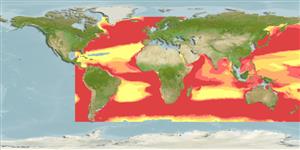Xenodermichthys copei (Gill, 1884)
Bluntsnout smooth-head
Beobachtung melden im Fish Watcher
| Native range | All suitable habitat | Point map | Year 2050 |

|
| This map was computer-generated and has not yet been reviewed. |
| Xenodermichthys copei AquaMaps Data sources: GBIF OBIS |
Hochladen Photos und videos
Pictures | Google BildXenodermichthys copei
Picture by Orlov, A.
Pictures | Google BildXenodermichthys copei
Picture by Orlov, A.
Klassifizierung / Names Namen | Synonyme | Catalog of Fishes(Gattung, Arten) | ITIS | CoL | WoRMS | Cloffa
> Alepocephaliformes (Slickheads and tubeshoulders.) > Alepocephalidae (Slickheads)
Etymology: Xenodermichthys: Greek, xenos = strange + Greek, derma = skin + Greek, ichthys = fish (Ref. 45335).
Eponymy: Edward Drinker Cope (1840–1897) was an American palaeontologist, anatomist, herpetologist and ichthyologist. [...] (Ref. 128868), visit book page.
More on author: Gill.
Etymology: Xenodermichthys: Greek, xenos = strange + Greek, derma = skin + Greek, ichthys = fish (Ref. 45335).
Eponymy: Edward Drinker Cope (1840–1897) was an American palaeontologist, anatomist, herpetologist and ichthyologist. [...] (Ref. 128868), visit book page.
More on author: Gill.
Environment: milieu / climate zone / depth range / distribution range Ökologie
seewasser bathypelagisch; tiefenbereich 100 - 2650 m (Ref. 4460), usually 100 - 1230 m (Ref. 47377). Deep-water; 70°N - 56°S, 90°W - 180°E (Ref. 57340)
Verbreitung Länder | FAO Gebiete | Ecosystems | Vorkommen | Point map | Einführungen | Faunafri
Atlantic Ocean: widely distributed, ranging north to Iceland in the eastern section (Ref. 4460). Pacific Ocean: on both sides, in tropical waters; Tasman Sea. Indian Ocean: including Great Australian Bight.
Size / Gewicht / Alter
Kurzbeschreibung Bestimmungsschlüssel | Morphologie | Morphometrie
Rückenflossenstacheln (insgesamt) : 0; Rückenflossenweichstrahlen (insgesamt) : 27 - 31; Afterflossenstacheln: 0; Afterflossenweichstrahlen: 26 - 30. Nodular luminous organ present sporadically on body; no luminous organ on shoulder (Ref. 13608).
Usually found near continental slopes (Ref. 4736). Bathypelagic (Ref. 58426). Feeds primarily on crustaceans (euphausiids, copepods, amphipods and decapod zoea), also ostracods and small cephalopods (Ref. 4736).
Life cycle and mating behavior Geschlechtsreife | Fortpflanzung | Ablaichen | Eier | Fecundity | Larven
Hauptreferenz
Upload your references | Referenzen | Koordinator | Partner
Markle, D.F., 1986. Alepocephalidae. p. 218-223. In M.M. Smith and P.C. Heemstra (eds.) Smiths' sea fishes. Springer-Verlag, Berlin. (Ref. 2711)
IUCN Rote Liste Status (Ref. 130435: Version 2024-2)
nicht bedroht (LC) ; Date assessed: 14 May 2014
CITES
Not Evaluated
Bedrohung für Menschen
Harmless
Nutzung durch Menschen
Fischereien: nicht kommerziell
FAO - Publication: search | FishSource |
Mehr Information
Population dynamics
Growth parameters
Max. ages / sizes
Length-weight rel.
Length-length rel.
Längenhäufigkeiten
Mass conversion
Rekrutierung
Dichte
Growth parameters
Max. ages / sizes
Length-weight rel.
Length-length rel.
Längenhäufigkeiten
Mass conversion
Rekrutierung
Dichte
Physiology
Body composition
Nutrients
Oxygen consumption
Swimming type
Swimming speed
Visual pigments
Fish sound
Diseases & Parasites
Toxicity (LC50s)
Body composition
Nutrients
Oxygen consumption
Swimming type
Swimming speed
Visual pigments
Fish sound
Diseases & Parasites
Toxicity (LC50s)
Genetics
Genetik
Heterozygosity
Vererbbarkeit
Genetik
Heterozygosity
Vererbbarkeit
Human related
Aquaculture systems
Aquakultur Profile
Zuchtlinien
Ciguatera cases
Stamps, coins, misc.
Aquaculture systems
Aquakultur Profile
Zuchtlinien
Ciguatera cases
Stamps, coins, misc.
Tools
E-book | Feldführer | Längenhäufigkeits Tool | Lebensdaten Tool | Punkt Karte | Classification Tree
| Catch-MSY |
Zusatzinformationen
Download XML
Zusammenfassung | Point data | Namen | Photos
Internet Quellen
AFORO (otoliths) | Aquatic Commons | BHL | Cloffa | BOLDSystems | Websites from users | FishWatcher Einträge suchen | CISTI | Catalog of Fishes: Gattung, Arten | DiscoverLife | ECOTOX | FAO - Publication: search | Faunafri | Fishipedia | Fishtrace | GenBank: Genom, nucleotide | GloBI | Google Books | Google Scholar | Google | IGFA World Record | MitoFish | Nationale Datenbanken | Otolith Atlas of Taiwan Fishes | PubMed | Reef Life Survey | Socotra Atlas | Tree of Life | Wikipedia: Gehe zu, Suchen | World Records Freshwater Fishing | Zoological Record
Estimates based on models
Preferred temperature (Ref. 123201): 3 - 19.7, mean 7.6 °C (based on 4609 cells).
Phylogenetic diversity index (Ref. 82804): PD50 = 0.7500 [Uniqueness, from 0.5 = low to 2.0 = high].
Bayesian length-weight: a=0.00389 (0.00180 - 0.00842), b=3.12 (2.94 - 3.30), in cm total length, based on all LWR estimates for this body shape (Ref. 93245).
Trophic level (Ref. 69278): 3.2 ±0.35 se; based on food items.
Widerstandsfähigkeit (Ref. 120179): mittel, Verdopplung der Population dauert 1,4 - 4,4 Jahre. (Assuming tmax>3).
Fishing Vulnerability (Ref. 59153): Low vulnerability (21 of 100).
Nutrients (Ref. 124155): Calcium = 18.9 [5.2, 84.2] mg/100g; Iron = 0.422 [0.123, 1.324] mg/100g; Protein = 14 [11, 17] %; Omega3 = 0.165 [0.052, 0.541] g/100g; Selenium = 12.8 [3.5, 51.4] μg/100g; VitaminA = 37.4 [5.1, 305.3] μg/100g; Zinc = 0.561 [0.250, 1.389] mg/100g (wet weight);




